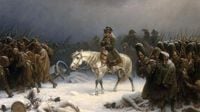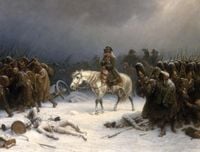In the annals of military history, few campaigns have been as catastrophic—or as shrouded in mystery—as Napoleon Bonaparte’s 1812 invasion of Russia. Marching into Russia with a force that some sources put at over 600,000 men, Napoleon’s Grande Armée seemed unstoppable. Yet, by the time the battered remnants staggered home, only a fraction survived. For generations, historians have pointed to the Russian winter, starvation, and, most notably, a deadly outbreak of typhus as the main culprits behind the disaster. But a new study, published on October 24, 2025, in Current Biology, is rewriting that narrative in a dramatic way.
Led by scientists at the Institut Pasteur in Paris, a team of researchers set out to answer a question that’s haunted the story of Napoleon’s Russian campaign: What, exactly, killed so many of his men? Armed with cutting-edge DNA analysis, they examined 13 teeth from soldiers buried in a mass grave in Vilnius, Lithuania—one of the final waypoints for the retreating army. The results, as reported by CNN and The New York Times, were as surprising as they were sobering.
Instead of the expected typhus pathogen, the scientists found traces of two other bacterial killers: Salmonella enterica, which causes paratyphoid fever, and Borrelia recurrentis, responsible for relapsing fever. Both diseases are serious, and both would have been especially deadly to soldiers already weakened by hunger, cold, and exhaustion. “It’s very exciting to use a technology we have today to detect and diagnose something that was buried for 200 years,” said co-author Nicolás Rascovan of the Institut Pasteur, as quoted by Current Biology. “Accessing the genomic data of the pathogens that circulated in historical populations helps us to understand how infectious diseases evolved, spread, and disappeared over time and to identify the social or environmental contexts that played a part in these developments.”
The findings challenge a long-standing consensus. For decades, typhus—a louse-borne disease notorious for sweeping through armies—was considered the primary infectious disease that decimated Napoleon’s troops. This belief was bolstered by a 2006 study that found DNA evidence of the typhus pathogen Rickettsia prowazekii and trench fever-causing Bartonella quintana in remains from the same Vilnius mass grave. However, that earlier research was limited by the technology of the time, and its conclusions were not definitive. The new high-throughput sequencing methods, which can analyze millions of DNA fragments even from highly degraded samples, offer a much clearer picture. “This is something that can be only done with these machines that are very powerful to go and sequence a lot of high quantity of DNA,” Rascovan explained to CNN.
What does this mean for our understanding of Napoleon’s doomed campaign? The answer is both more complex and, in some ways, more tragic. The study’s lead author, Rémi Barbieri, now at Estonia’s University of Tartu, emphasized that the presence of multiple infectious diseases—not just typhus—likely played a role in the army’s collapse. “Previously, we just thought that there was one infectious disease that decimated the Napoleon army—the typhus,” Barbieri told CNN. “Instead, the researchers found something unexpected, opening the door to potentially uncovering other infectious diseases that could have contributed to the soldiers’ deaths.”
Relapsing fever, transmitted by lice, can cause high fevers, joint pain, severe headaches, nausea, vomiting, and extreme fatigue—symptoms that closely resemble those of typhus. Paratyphoid fever, on the other hand, is spread through contaminated food or water and brings high fever, headache, weakness, and abdominal pain. Both diseases would have found fertile ground among soldiers who, upon reaching Moscow, discovered a city deliberately burned and abandoned by the Russians. There was no food, no clean water, and no shelter—just the onset of a brutal winter and a forced retreat through a devastated landscape.
The suffering was immense. Historical accounts, like those of French physician Dr. J.R.L. de Kirckhoff, paint a harrowing picture: “Soldiers unable to go further fell and resigned themselves to death, in that frightful state of despair which is caused by the total loss of moral and physical force, which was aggravated to the utmost by the sight of their comrades stretched lifeless on the snow.” According to The New York Times, Dr. de Kirckhoff listed not only typhus but also diarrhea, dysentery, fevers, pneumonia, and jaundice among the afflictions that plagued the troops.
Yet, the researchers behind the new study are careful not to draw sweeping conclusions from their findings. The sample size—just 13 teeth—is too small to definitively say which diseases were most responsible for the staggering death toll. “I by no means thought the two pathogens identified by his group were the sole cause of the demise of the troops,” Rascovan cautioned in The New York Times. He and his colleagues stress that starvation, dehydration, and freezing temperatures were the critical factors that left the men vulnerable to any infection. “In those conditions, any infectious disease can kill people,” he said.
The numbers themselves are staggering. Out of the estimated 500,000 to 615,000 men who marched into Russia, only about 110,000 returned. Of the casualties, roughly 100,000 died in battle, but as many as 300,000 perished from cold, starvation, and disease, according to Current Biology. The retreat from Moscow, ordered in October 1812, became a death march across a frozen wasteland. The scale of suffering was so great that Kyle Harper, a historian at the University of Oklahoma, remarked, “The attrition of the army is extraordinary, and underscores how much prior to the 20th century what we think of as wars are primarily medical events.”
The impact of infectious disease on military history is a lesson that resonates even today. As Cecil Lewis, an ancient DNA researcher quoted by CNN, put it: “Studying historical and ancient pathogens, their place in history, offers a glimpse into the evolutionary paths organisms have taken, some now extinct, others forming the foundation of present-day pathogens. These data help us better understand the possibilities for how pathogens can impact lives, evolve and persist, which is crucial for anticipating and managing future threats.”
Paratyphoid fever and relapsing fever are still present in the world today, though they are far less common and deadly than in Napoleon’s time. The disaster of 1812 not only marked the beginning of the end for Napoleon’s rule—it also inspired literary masterpieces like Tolstoy’s War and Peace. But perhaps most importantly, it serves as a stark reminder of the devastating power of disease, especially when combined with the horrors of war and the unforgiving hand of nature.
With each technological leap, scientists are peeling back the layers of history, revealing the true causes of past tragedies. And as they do, the story of Napoleon’s Russian campaign becomes not just a tale of military ambition and defeat, but also a cautionary saga of human suffering and resilience in the face of overwhelming odds.


